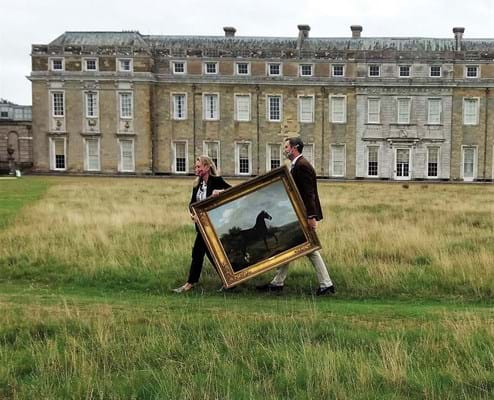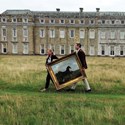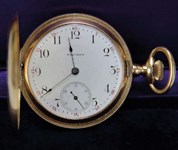It may be tempting to dismiss 2020 as the year of closures, postponements and cancellations. There was so much, in the art and antiques world and beyond, that did not happen in 2020.
However, it could just be that the 10 stop-start months since ATG carried its first coronavirus story (the cancellations of fairs in Hong Kong published in February) will be the most important in the recent history of the trade. The global health emergency has accelerated shifts in the market that most of us assumed would take years. And many will be here to stay in 2021 and beyond.
As early as March, when the world’s top fine art fair, TEFAF in Maastricht, was truncated after a positive test among the exhibitors, it quickly became clear that dealers would have to do things differently this year.
As the furlough schemes, related grants and other provisions had winners and losers, even the most old-fashioned businesses were encouraged to grasp the digital nettle. Some dealers ramped up their output of e-catalogues or launched informative social media and newsletter posts aimed at staying in touch and building their brand.
Others simply took the time to upload more stock to the website, finally completing that ‘must do when I have I time’ list.
Embracing the internet
Among the individual highlights were Philip Mould’s Art in Focus Instagram series, Les Enluminures’ Digital Delights newsletters, Richard Hoppe’s online Armchair Antiques Fair.
The result has been simple: dealers are now embracing the internet like never before and are increasingly selling online to buyers who had never come to their galleries to view an item.
None of this will mean the end of bricks and mortar – plenty of life is left in London’s West End, the various hot-spots around the country and antiques shops which continue to play their part in the UK’s towns and villages – but most traders agree that the pandemic has accelerated a trend that was already building gradually (and one which their trade associations had been gently prompting them for some years to gear up for).
Dealer portals also grew in importance with the battle for primacy in this market very much ongoing. Both long-established players such IACF’s loveantiques.com and newcomers such as 2Covet experienced high levels of growth in visits to their sites in 2020.
In 2021 at the high-value end of the market The Bruno Effect will be the next contender hoping to chip away at 1st Dibs, currently that sector’s largest player, while trade associations may yet have a big role to play.
BADA no longer has its own fair to manage but it does have the website bada.org that was showing an encouraging increase in online sales by the end of the year. It will be a missed opportunity if BADA and LAPADA end 2021 without a serious foothold in this market.
The circumstances could hardly be more favourable for such ventures: those dealers whose business was traditionally concentrated at fairs have experienced far lower levels of trading in 2020.
Fairs forced to close
Fairs and markets will, of course, bounce back. That said, beyond a few highlights (see page 56), and saluting the determination of organisers to do whatever they can for their events, there is little sugar-coating to be applied to the year just gone.
The showground scene was able to put on fewer than half its scheduled outings. The Open Art Fair (which closed after two days) and the Petworth fair (an ‘outdoor’ event held in a tent in the grounds of the National Trust property) were the only two quality vetted fairs held in the UK between March and December.
Live events are deeply missed but a number of fairs did achieve some decent sales via virtual means – online versions of existing events such as the ABA’s Firsts Online, Tribal Art London, Art & Antiques for Everyone, TEFAF Online and new ventures like ArtCity. In the US, the Antiquarian Booksellers’ Association of America’s recent Boston virtual fair, which ran from November 12-14, generated sales of $1.1m.
These ‘viewing rooms’ had previously been at best a useful add-on but they have generated sufficient interest during the Covid-19 months to demonstrate they will have an important role to play in the promotion of art and antiques after physical fairs return.
When paying to exhibit in person, dealers will now expect a high-quality virtual version to run in parallel.
What quickly became apparent in 2020 was that a slick, tight schedule and the full engagement of dealers who are exhibiting go a long way to making on online fair fell like an event.
The Provincial Booksellers’ Fairs Association’s (PBFA) monthly online book fair is a good example: the November 29 fair featured 80 participating dealers and more than 1000 new items. So well has the format been received that it is being continued as a permanent fixture even when in-person events resume.
Salerooms adapt
While Covid-19 restrictions limited the number of fairs that could be held this year, it was a different story for auctions.
In early March, live auctions, even with strong double-digit online sell-through, were still being held in a way that would be quite recognisable not just to James Christie and Samuel Baker but to the Babylonians who first employed this method of sale more than 3000 years ago.
No more. Online trading – whether live or timed auctions – has taken centre stage for the buying and selling community.
Clearer government regulations and guidance would have been helpful. But all those who embraced the ‘new normal’ were seldom disappointed. Records of all types were broken time and again and with them any of the remaining psychological barriers that persisted around the type and value of merchandise that could be dispersed without an in-person viewing.
Buying art and antiques in this way is different. However, those buyers who hitherto would purchase only offline showed they were more than willing to give it a go and it turned out that the medium already had what it needed: the very traditional value of trust and the age-old lure of good-quality, market-fresh objects offered at buyable prices.
The experiences registered across the past year by those who have taken the leap will go a long way to determining the extent to which buying behaviour has forever changed. Certainly, the auction houses conducting the sales are shifting in this direction.
Coronavirus did not, immediately at least, occasion the sort of cull among them that is now afflicting high-street retail brands.
There have been closures but no more than typical. Penrith Farmers & Kidd in Cumbria shut its fine art operation, with head of department Michael Bowman joining local rival Mitchells; Hansons acquired the assets of Holloway’s and Charles Ross Auctioneers; Special Auction Services took over Aston’s premises and Minster Auctions opened after Brightwells closed its fine art department. But, timing aside, these were the stuff of opportunity and ambition rather than Covid-19 woes.
Middle-market success
In truth, from Banksy prints to Qing ceramics, the middle-market auction has boomed. Sell-through rates were remarkably high. It is nothing short of remarkable that in a year when doors were shut for more than three months, many auction houses are close to meeting the budget they set out at the start of the year – and some will have increased their annual totals significantly.
“Our hammer total for 2020 is set to be up by more than 50% year-on-year,” says Forum Auctions chief executive Stephan Ludwig. “We see 2020 as a year of quantum change for the industry. While our own emphasis on exclusively online auctions comfortably predates the Covid-19 crisis, there is no question that the market’s shift to holding all auctions online has suited Forum’s business model well.”
The reasons are many. Lockdown prompted the focus on the home and, for some at least, the spare hours and the disposable income to make improvements. More eyeballs than ever were scrolling through catalogues on-screen and with shops and fairs closed, less was going on elsewhere.
The technology also played its part with virtual viewings via Zoom and a myriad of other platforms and lot descriptions receiving enhancements such as videos, multiple images and condition reports, all of which helped to instil confidence.
The market also moved a little closer to the dream of ‘click and collect’ antiques purchasing.
There will always be items sold at auction for modest amounts that cannot be safely shipped to the other side of the coudose of reality aside – the role of the delivery firm and its staff received a boost during lockdown. The government classed logistics businesses as essential services and the reliable extra-mile efforts they frequently provided will lead to more converts.
What they may be delivering fewer of in the future are printed catalogues. While they may be one of the best calling cards an auction house has, it is one with cost to the bottom line that looks a little out of kilter with a live online-only auction. “In 2019 we spent £250,000 on printed catalogues and £40,000 on stamps,” says Leigh Osborne, owner at Chiswick Auctions. “This year we spent £20,000 and £3000.”
Auction houses are also toying with the idea of dropping regular public viewings for at least their second-string sales – many held no viewings for their auctions in November due to the prevailing restrictions and their clearance rates were unaffected. Privately some are even questioning if they really need large, prominent and welcoming premises given that the customers paying the lion’s share of the bills seldom visit.
The fundamentals of the business – the value of expertise, client trust and the ability to find buyers and sellers – will not disappear. But the UK’s auction landscape may soon begin to resemble that of the US where, for many smaller firms, ‘headquarters’ is a website address rather than a street number and a zip code.
Tougher at the top
Despite the problems inherent in sourcing goods during a lockdown, as the year progressed the phone kept ringing for regional auction houses. It became evident that key pieces of the fine art auction market were being willingly given up by the big London firms.
The changes at the top – such as de-emphasising the decorative arts market – may be among 2020’s greatest long-term impactors as the business filters down to provincial firms.
The year will not go down as a vintage one for the world’s biggest auction houses. Huge logistical adjustments were required while facing down the challenge of a temporary dwindling of blue-chip consignments.
Making direct year-on-year comparisons for performance at the big four auction houses is difficult because of all of those calendar changes, but in the first half of the year the numbers had fallen by as much as 75%.
A surge in private sales rapidly filled much of the gap, with Christie’s announcing to reporters last week that its total volume (auctions plus private sales) at the end of 2020 was down 25% year-on-year. Sotheby’s year-end numbers also showed an increase in private sales, up 50% year-on-year to $1.5bn.

Auctioneer Oliver Barker takes bids in London via video-link from Sotheby’s other international offices.
Their online sales also helped, as did the live-streamed events, some conducted relay-style across different continents, that kept the high-stakes action going. This global approach will be maintained and intensified, not wound down, in the future.
All the top firms furloughed staff and not all the employees returned. It is the drip, drip, drip loss of specialists in traditional collecting areas that will make all of this very difficult for them to reverse. Details were thin on the ground but it emerged that (at Christie’s, for example) some departments would merge, some would close and others will move. Next year’s Asian Art in London festival will be without a flagship sale at King Street: the firm’s best Chinese art is moving from its decades-long home in London to Paris.
All four revisited a much older strategy too: raising their buyer’s premiums.
Sotheby’s introduced a so-called ‘overhead’ premium – a new 1% flat fee for buyers applicable on all lots – and the other salerooms followed in kind. Christie’s, Bonhams and Phillips all raised existing premium levels via amended thresholds. A successful £10,000 bid at Bonhams will now mean a bill of £13,300.

Sotheby’s sale of Old Masters in New York in late January 2021 includes Sandro Botticelli’s 'Young Man Holding a Roundel', dubbed ‘one of the greatest Renaissance paintings remaining in private hands’, estimated to sell in excess of $80m.
Whatever premium buyers might be paying, a glut of material is waiting in the wings to be consigned by the vendors once some wider stability returns, perhaps towards the spring.
In the UK at least, a potential rise in capital gains tax to help pay for the war debt of Covid-19 may well persuade potential consignors to sell before the new rules are brought in.
Regulation, regulation, regulation
That is just one of many possible or definite regulatory changes affecting market in 2021 and beyond. For firms operating in the art and antiques sector there can scarcely have been a more important time to be a member of a trade association.
Covid-19 may have taken other impeding challenges off the front page but they remain very much on the agenda. Whether or not the European Union and the UK ever manage to agree a trade deal, moving goods between the two jurisdictions will be more difficult, with new paperwork and inevitable delays.
For example, items containing the parts of endangered species (notably rosewood and antique ivory) will require export permits when moved overseas from January 1.
Fortunately, the shipping trade has been preparing for Brexit on a ‘worst-case scenario’ basis. It is confident that, with contingencies in place, the system will find a way to operate.
Brexit will not be the only issue to deal with. The 5th Anti-Money Laundering Directive (known as 5AMLD) requires auction houses, art galleries and dealerships to conduct stricter due diligence on buyers who purchase ‘works of art’ above a threshold of €10,000.
So-called Art Market Participants (AMPs who sell paintings, drawings, prints and sculptures, tapestries, signed photographs and ceramics) need to register and a pay a fee with HMRC by June 10, 2021. Those outside the definition (selling only furniture, unsigned ceramics, jewellery and collectors’ items such as coins, medals and stamps) do not have to register. But existing laws still require due diligence for all transactions.
New battlegrounds
The dealing and collecting lobby group FACT, which sought to overturn the Ivory Act 2018 – a near-total ban in the UK on the trade of items containing ivory – was denied a final appeal by the Supreme Court in August this year. The wrangling has bought some time and allowed many collections of pre-1947 ivory to be sold in 2020.
The battleground now moves to the minutiae of the law: the precise scope of its exemptions and how it might be the implemented. Just how, for example, will the phrase ‘of outstandingly high artistic, cultural or historical value’ be interpreted in practice?
The Department for Environment, Food and Rural Affairs (Defra) has not commented on the timing of a consultation or the content of the secondary legislation. But, with issues such as species and biodiversity loss still centre stage, it would be remarkable if 2021 were to pass without the 2018 law coming into play.
Another ongoing issue is the disquiet regarding looted art and the repatriation of cultural heritage. This year ended with a spectacular own goal by Unesco, which packed its 50th anniversary advertising campaign ‘The Real Price of Art’ with stories of objects it said had been recently looted in conflict areas and smuggled into the European art market.
In fact, several of the pieces had long been in the collection of the Met in New York and had been acquired legitimately. Any misappropriated work of art deserves the oxygen of publicity but surely dealers were entitled to ask: if the business of stolen art is as widespread as is being claimed, then why did Unesco have to search so far for examples to use in its campaign?
A more measured approach would be appreciated by the trade. In the meantime, a successful vaccine roll-out and a reliable internet connection will be on everyone’s wish-list for 2021.


















